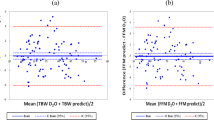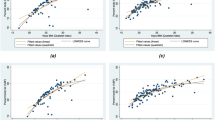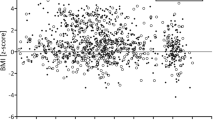Abstract
OBJECTIVE: To determine the efficacy of applying specific body composition techniques to, and assess the relationship between body mass index (BMI) and body fat levels for Chinese Australian females.
DESIGN: Statistical comparative analysis of body composition techniques.
SUBJECTS: Australian resident females of Chinese extraction (n=40) (aged 18–45 y, mean 32.5±8.0; BMI range 15.7–30.9 kg/m2, mean 21.7±3.1 kg/m2, median 20.8 kg/m2).
MEASUREMENTS: Body composition determined using bio-electrical impedance analysis (BIA), the skin-fold equations of Durnin and Womersley (D&W) and a deuterium dilution technique. Body size was calculated as the body mass index (BMI) weight/height2 (kg/m2).
RESULTS: With a median BMI of 20.8, range 15.7–30.9, an acceptable BMI existed for 87.5% of the subjects (mean (s.d.) 21.7±3.1 kg/m2). Percentage fat mass (%FM) from the deuterium dilution technique (mean (s.d.) 35.6±6.4) suggested 75% were overweight or obese. %FM from the D&W equation (mean (s.d.) 28.0±3.9) and BIA (mean (s.d.) 29.4±5.1) also indicated a tendency towards overweight or obese. The deuterium technique was significantly correlated and significantly different to the D&W eqn, r=0.71 P=0.001; and BIA, r=0.77, P=0.001. Bland and Altman analysis indicated that bias existed between the techniques (BIA mean (s.d.)−6.7±4.1) and D&W equation mean (s.d.)−6±4.5) when compared to the deuterium method.
CONCLUSIONS: Despite a low mean BMI, body fat levels determined by the three methods suggested that, overall, an unsatisfactory body composition existed. The levels of overweight and obesity (%FM>30) were higher than reported in previous research despite a mean BMI lower than the Australian national average. Comparative analysis suggested that the body fat prediction techniques used may be precise but not accurate. Comparative results obtained for the BIA and D&W equation techniques suggest an overestimation of body fat levels for leaner individuals and under estimation for overfat individuals. The results support the notion that accurate determination of body composition and the determination of appropriate body size may require equations developed for specific ethnic populations.
This is a preview of subscription content, access via your institution
Access options
Subscribe to this journal
Receive 12 print issues and online access
$259.00 per year
only $21.58 per issue
Buy this article
- Purchase on Springer Link
- Instant access to full article PDF
Prices may be subject to local taxes which are calculated during checkout



Similar content being viewed by others
References
Elrick H . Exercise is medicine Physician Sports Med 1996 24: 72–78.
Ackland TR . Techniques in the measurement and assessment of body composition. In: Hills AP, Wahlquist ML, (eds) Exercise and Obesity Smith-Gordon: London 1994 151–168.
Stolarczyk LM, Heyward VH, Hicks VL, Baumgarter RN . Predictive accuracy of bioelectrical impedance in estimating body composition of Native American women Am J Nutr 1994 59: 964–970.
Dart AM, Qi XL . Determinants of arterial sgifness in Chinese migrants to Australia Atherosclerosis 1995 117: 263–272.
Ge K, Weisell R, Guo X, Cheng L, Ma H, Zhai F, Popkin BM . The body mass index of Chinese adults in the late 1980s Eur J Clin Nutr 1994 48 (Suppl): S148–154.
Wang J, Thornton JC, Russell M, Burastero S, Heymsfield S, Pierson RN . Asians have lower body mass index (BMI) but higher percent body fat than do whites: comparisons of anthropometric measurements Am J Clin Nutr 1994 60: 23–28.
Hsu-Hage BH, Wahlqvist ML . Cardiovascular risk in adult Melbourne Chinese Aust J Public Health 1993 17: 306–313.
Heyward VH . Evaluation of body composition: current issues Sports Med 1996 22: 146–156.
Jackson AS, Pollock ML, Ward A . Generalised equations for predicting body density of women Med Sci Sports Exercise 1980 12: 175–182.
Durnin JVGA, Womersley J . Body fat assessment from total body density and its estimation from skinfold thickness: measurements on 481 men and women aged from 16 to 72 y Br J Nutr 1974 32: 77–97.
Eston R, Evans R, Fu F . Estimation of body composition in Chinese and British men by ultrasonographic assessment of segmental adipose tissue volume Br J Sports Med 1994 28: 9–13.
Eston R, Fu F, Fung L . Validity of conventional anthropometric techniques for predicting body composition in healthy Chinese adults Br J Sports Med 1995 29: 52–56.
de-Wart FG, Li R, Deurenberg P . Comparison of body composition assessments by bioelectrical impedance and by anthropometry in pre-menopausal Chinese women Br J Nutr 1993 69: 657–664.
Liu HY, Lu YF, Chen W J . Predictive equations for basal metabolic rate in Chinese adults: a cross validation study J Am Diet Assoc 1995 95: 1403–1408.
Deurenberg P, Van der Kooy K, Leenen R, Westrate JA, Seidell JC . Sex and age specific prediction formulas for estimating body composition from bioelectrical impedance: a cross validation study Int J Obes 1991 15: 17–25.
Borowitz D, Conboy K . Are bioelectrical impedance measurements valid in patients with cystic fibrosis? J Paediat Gastroenterol Nutr 1994 18: 453–456.
Jiang ZM, Yang NF, Chou C, Liu ZH, Sun TL, Chen YH, Xue BZ, Fei LM, Tseng HC, Brown E, Scheltinga M, Wilmore DW . Body composition in Chinese subjects: Comparisons with data from North America World J Surg 1991 15: 95–101.
Kushner RF, Schoeller DA . Estimation of total body water by bioelectrical impedance analysis Am J Clin Nutr 1986 44: 417–424.
Gray DS, Bauer M . The relationship between body fat mass and fat free mass J Am College Nutr 1991 10: 63–68.
Haines CJ, Chung TK, Masarei JR, Tomlinson B, Lau JT . An examination of the effect of combined cyclical hormone replacement therapy on lipoprotein(a) and other lipoproteins Atherosclerosis 1996 119: 215–222.
Fukagawa NK, Bandini LG, Dietz WH, Young JB . Effect of age on body weight and resting metabolic rate J Gerontol Biol Sci Med Sci 1996 51: 71–73.
Virmani R, Avolio AP, Mergner WJ, Robinowitz M, Herderick EE, Cornhill JF, Guo SY, Liu TH, Ou DY, O'Rourke M . Effect of aging on aortic morphology in populations with high and low prevalence of hypertension and atherosclerosis. Comparison between occidental and Chinese communities Am J Pathol 1991 139: 1119–1129.
Behnke AR, Wilmoe JH . Evaluation and Regulation of Body Build and Composition Prentice Hall: New Jersey 1974.
Wang J, Deurenberg P . The validity of predicted body composition in Chinese adults from anthropometry and bioelectrical impedance in comparison with densitometry Br J Nutr 1996 76: 175–182.
Bell NA, McClure PD, Hill RJ, Davies PSW . Assessment of foot-to-foot bioelectrical impedance analysis for the prediction of total body water Eur J Clin Nutr 1998 52: 856–859.
Forbes GB . Methods for determining composition of the human body Pediatrics 1962 29: 477–494.
Davies PSW, Hicks CJ, Halliday D, Preece MA . The prediction of total body water using bioelectrical impedance in children and adolescents Ann Hum Biol 1988 15: 237–240.
Bland JM, Altman DG . Statistical methods for assessing agreements between methods of clinical measurement Lancet 1986 1: 307–310.
Segal KR, Gutin B, Presta E, Wang J, Van Itallie TB . Estimation of human body composition by electrical impedance methods: a comparative study J Appl Physiol 1985 58: 1565–1571.
Kemper HCG, Post GB, Twisk JWR, van Mechelen W . Lifestyle and obesity in adolescence and young adulthood: results from the Amsterdam Growth and Health Longitudinal Study (AGAHLS) Int J Obes Relat Metab Disord 1999 23 (Suppl): S34–S40.
Ezell DM, Geiselman PJ, Anderson AM, Dowdy ML, Womble LG, Greenway FL, Zachweija JJ . Substrate oxidation and availability during exercise in non-obese, obese, and post-obese sedentary females Int J Obes Relat Metab Disord 1999 23: 1047–1056.
Author information
Authors and Affiliations
Corresponding author
Rights and permissions
About this article
Cite this article
Lanham, D., Stead, M., Tsang, K. et al. The prediction of body composition in Chinese Australian females. Int J Obes 25, 286–291 (2001). https://doi.org/10.1038/sj.ijo.0801473
Received:
Revised:
Accepted:
Published:
Issue Date:
DOI: https://doi.org/10.1038/sj.ijo.0801473
Keywords
This article is cited by
-
Criterion-Related Validity of Field-Based Methods and Equations for Body Composition Estimation in Adults: A Systematic Review
Current Obesity Reports (2022)
-
Relationship of total body fatness and five anthropometric indices in Chinese aged 20–40 years: different effects of age and gender
European Journal of Clinical Nutrition (2006)
-
Improved Prediction of Body Fat by Measuring Skinfold Thickness, Circumferences, and Bone Breadths
Obesity Research (2005)
-
Prediction of Percentage Body Fat in Rural Thai Population Using Simple Anthropometric Measurements
Obesity Research (2005)



